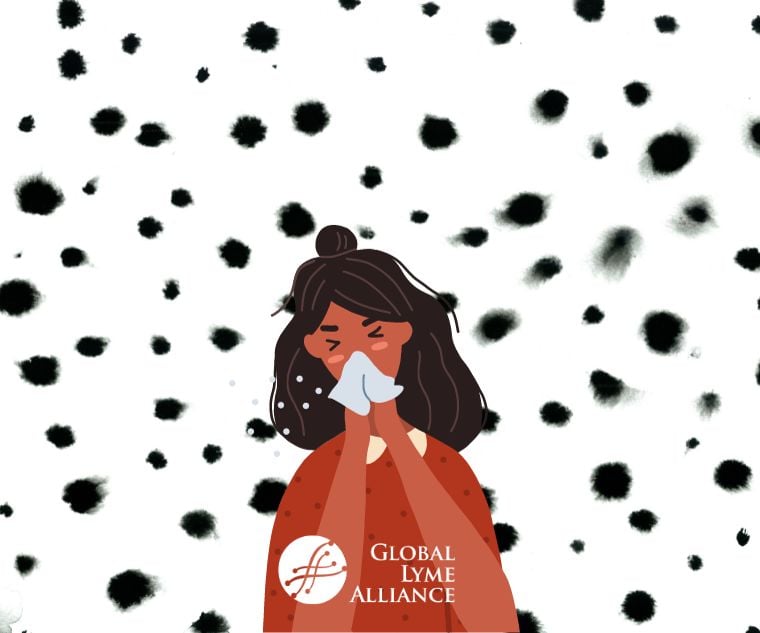
Learn how mold illness and Lyme disease are connected and can impact your health. Discover the overlapping symptoms, the link between these two conditions, and find out about proper diagnosis and treatment options for both illnesses.
Lyme disease is a complex tick-borne illness that is often misunderstood, at least beyond its basic, early manifestations of an erythema migrans rash and flu-like symptoms. Of the 476,000 people diagnosed with Lyme disease in the United States every year, 10 to 20% go on to experience chronic illness, and many patients who are yet untreated due to difficulties in diagnosis also develop chronic Lyme disease.
Like Lyme, mold illness is also often misunderstood. The two illnesses not only have similarities in symptoms, but also can affect a person’s immune system concurrently. We will be shedding light on how these conditions are interconnected and how they impact our well-being.
Understanding Mold Illness
Mold illness, also known as mold toxicity or mold illness syndrome, refers to the adverse health effects caused by exposure to mold spores and mold toxins. Indoor mold exposure is especially harmful, and can happen at home, at work, at school, or in any other building where you spend time. Toxic mold, such as black mold, can grow in damp environments such as basements, bathrooms, and areas where water damage has occurred. You might notice mold growth by a musty smell or a damp ceiling, but it’s not always that obvious.
As mold settles into an indoor environment, the mold spores release mycotoxins, which are secondary metabolites that are harmful. When inhaled or ingested, the mycotoxins can have detrimental effects on our health. Common symptoms of mold illness include:
- Chronic fatigue
- Joint pain
- Respiratory problems
- Cognitive impairment or brain fog
- Headaches
- Mental illness such as anxiety, depression, and mood swings
- Weight loss or gain
- Chronic sinusitis
Understanding Lyme Disease
If you’re thinking that list sounds a lot like Lyme disease, you’re not wrong. While there are important differences between mold illness and Lyme disease, they cause many overlapping symptoms. While mold illness is a fungal infection, Lyme is a bacterial infection caused by the bacteria Borrelia burgdorferi. The bacteria, transmitted through a black-legged tick bite, can cause a range of symptoms and complications if left untreated.
While early (Stage 1) Lyme disease often (but not always) causes a rash, as well as flu-like symptoms and joint aches, untreated Lyme allows the bacteria to move into other parts of the body such as the nervous system and heart. Stage 2 and Stage 3 Lyme disease symptoms can include:
- Severe headaches and neck stiffness
- Lyme arthritis (different than rheumatoid arthritis)
- Muscle aches and joint pains
- Lyme carditis
- Facial palsy
- Numbness or tingling of the hands and feet
- Severe extreme fatigue
- Neurological symptoms such as brain fog, vertigo and dizziness
The Link Between Mold Illness and Lyme Disease
As we’ve discussed, mold illness and Lyme disease have many overlapping symptoms such as chronic fatigue, joint pain, brain fog and other neurological issues. It is also possible to have both Lyme disease and mold toxicity, and for the two conditions to impact each other. Mold toxicity can weaken the immune system, making individuals more susceptible to chronic infections like Lyme disease. Lyme disease also weakens the body, making it more difficult to handle or detoxify mold.
If someone with mold toxicity gets Lyme, mold colonization can negatively impact the Lyme disease patient’s ability to heal. Both mold and Lyme disease cause inflammation; having both in your system can trigger chronic inflammatory response syndrome, where instead of calming down after fighting infection, the immune response of inflammation goes into overdrive. This can make it hard for a person to feel better.
Mycotoxins can also suppress the immune system, making it more difficult to fight Lyme or other infection. Even with proper treatment, when someone has mold toxicity, it may be harder for antibiotics to fight the bacteria, making the person feel sicker for longer.
Proper Diagnosis and Treatment for Mold Illness and Lyme Disease
Both Lyme disease and mold illness need to be diagnosed and treated by a medical professional. If you suspect you have Lyme disease, it’s best to see a Lyme Literate Medical Doctor (LLMD), who may also be able to determine if you have mold illness. A functional medicine doctor may be able to do specific testing to determine if you have mold illness. It is best to find medical professionals with expertise in both illnesses. For both Lyme disease and mold illness, a personalized treatment plan is necessary based on individual symptoms and medical history.
***








